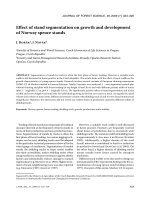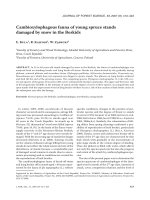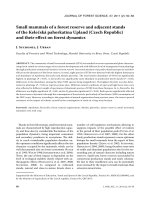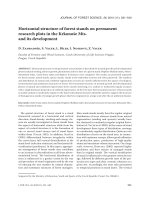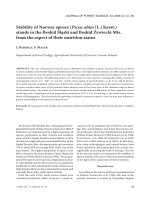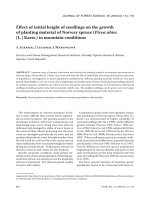Báo cáo lâm nghiệp:"Competition for water between beech seedlings and surrounding vegetation in different light and vegetation composition conditions" ppsx
Bạn đang xem bản rút gọn của tài liệu. Xem và tải ngay bản đầy đủ của tài liệu tại đây (178.05 KB, 8 trang )
593
Ann. For. Sci. 60 (2003) 593–600
© INRA, EDP Sciences, 2004
DOI: 10.1051/forest:2003051
Original article
Competition for water between beech seedlings and surrounding
vegetation in different light and vegetation composition conditions
Lluis COLL
a
*, Philippe BALANDIER
a
, Catherine PICON-COCHARD
b
, Bernard PRÉVOSTO
a
, Thomas CURT
a
a
CEMAGREF – U.R. DFCF, Applied Ecology of Woodlands Research Team, 24 avenue des Landais, BP 50085, 63172 Aubière Cedex, France
b
INRA – U.R. Agronomie, 234 avenue du Brezet, 63039 Clermont-Ferrand, France
(Received 24 June 2002; accepted 10 February 2003)
Abstract – To gain a better understanding of beech growth requirements and assess the competition with the surrounding vegetation at two
successional stages after agricultural land abandonment, we introduced two-year-old beech seedlings (i) in a recently abandoned meadow (one
half weeded) and (ii) in an old meadow colonised by 25-year-old natural Scots pine, with one part thinned to increase light availability at ground
level. Beech seedlings presented significantly different stem diameter growth rates according to vegetation composition (grasses or dicotyledon
species) and light availability for both successional stages. Grass species, which developed efficient strategies to extract soil water, competed
strongly with beech seedling compared with dicotyledon species. Water competition led to a strong reduction of beech diameter growth. For a
given vegetation composition, increasing light availability improved beech growth.
competition / Fagus sylvatica L. / understorey vegetation / grasses / root development / soil water content
Resume – Compétition pour l’eau entre de jeunes hêtres et la végétation environnante en fonction du niveau de lumière et de la
composition de la végétation. Afin de mieux comprendre les conditions de croissance du hêtre et d’évaluer l'impact de la compétition par la
végétation à deux stades de la succession végétale après abandon de terres agricoles, des plants de hêtre de deux ans ont été introduits : (i) dans
une prairie récemment abandonnée (dont la moitié était désherbée) et (ii) dans une prairie abandonnée plus anciennement et colonisée par un
boisement naturel de pin sylvestre de 25 ans (en partie éclairci pour obtenir différents niveaux d’éclairement au niveau du sol). Le taux de
croissance en diamètre des jeunes plants de hêtre a été significativement différente en fonction de la composition de la végétation (graminées
ou dicotylédones) et de l'éclairement. Les graminées ont la capacité de puiser l'eau très efficacement dans le sol en comparaison des
dicotylédones, ce qui les rend très compétitives vis-à-vis des jeunes hêtres. Cette compétition a diminué la croissance en diamètre des jeunes
plants. Par contre, à composition égale de la végétation, la croissance des plants de hêtre augmente avec le niveau d'éclairement.
compétition / Fagus sylvatica L. / végétation forestière / graminées / croissance racinaire / teneur en eau du sol
1. INTRODUCTION
Grazing abandonment in the “Chaîne des Puys”, a volcanic
massif located in the French Massif Central, has led to a natural
afforestation of former agricultural land by pioneer trees such
as Scots pine (Pinus sylvestris L.) [11, 24] and Silver birch
(Betula pendula Roth.). Natural establishment of shade-toler-
ant broadleaved species such as beech (Fagus sylvatica L.) is
observed beneath these pioneer stands [10]. Since beech for-
ests in this area are assigned higher economic and ecological
value than most of the current pine stands, beech restoration is
of major interest for land managers.
The ecological requirements for beech establishment and
development in forest stands have been studied in different site
conditions [9, 20, 28, 29]. A light value of about 40% of inci-
dent radiation at ground level has generally been reported as
optimal for beech seedling growth [23]. However, such a light
level also favours thick ground vegetation [2] which may com-
pete with the seedlings. The plant competitive ability differs
from one species to another and little attention has been paid to
the flora composition [8] and its consequences on resource
availability for young seedlings [16, 21]. Generally, grasses
(Graminaceae) are considered as the most harmful for young
tree growth through competition for water or nutrients [12, 14]
and other works have found differences in the competitive
abilities of arborescent and non-arborescent species [4, 7].
The aim of this study was to characterise the below-ground
competitive ability for water of two main classes of vegetation,
grasses and dicotyledon species. We report also on the conse-
quences of this competition on beech seedlings growth and set-
tlement at two different successional stages after land aban-
donment, with different vegetation composition and light
availability. Data could be used to adjust silvicultural opera-
tions to restore a beech forest from meadow at different stages
after agricultural abandonment.
*
Corresponding author:
594 L. Coll et al.
2. MATERIALS AND METHODS
2.1. Study area
The experimental site is located in the southern part of the “Chaîne
des Puys”, a volcanic mid-elevation massif in the French Massif Cen-
tral (45° 42’ N, 2° 59’ E). The climate is mountainous with oceanic
influences (annual rainfall 820 mm, evenly spread over the year,
annual mean temperature 7 °C ). Soils are well watered in the upper
horizon but they present risks of rapid summer dryness since they
have developed on a substrate of basaltic ash-fall deposits or lava
blocks. In such soils, weathering leads to the formation of non-crys-
talline materials, especially allophone and Al/Fe humus complex
through a process of andosolisation [26]. These materials exhibit the
typical morphological characteristics of andosols including dark col-
our, low density, microaggregated structure, loamy silt texture and
thixotropic touch. They have a pH
water
= 6 with a rich-organic upper
horizon (0–15 cm). Soil analyses did not show evidence of mineral
deficiency. Scoria are found at a depth of between 60 and 80 cm. In
such horizons, water capacity is very low.
2.2. Experimental design
The experiment was carried out at two successional stages in the
process of woody colonisation after agricultural land abandonment:
(i) in a recently abandoned meadow (M) and (ii) in an old meadow
colonised by a natural dense 25-year-old Scots pine stand (P). Two
plots were set up in each stage (Tab. I): in the former meadow (M),
one half of the area was periodically hand-weeded to maintain a bare
soil and prevent installation of vegetation (M – V, 75 m
2
). The other
half was left in natural conditions with no management (M + V,
75 m
2
). Plots were located close to each other in comparable site con-
ditions. The dense Scots pine stand (P) presented very low values of
transmitted PAR under the pine canopy (9.9%) and the understorey
vegetation was very sparse (P – V plot). In order to increase light
transmission to the soil and so allow the development of the under-
storey vegetation, a part of the stand was partially thinned in March
2000 to get 41.4% of transmitted PAR (P + V). Each plot (P – V and
P + V) had a surface of about 400 m
2
(20 × 20 m).
The ground-vegetated plots (M + V and P + V) differed markedly
in plant species composition as recorded in July 2001 (i.e. two years
after thinning in the P + V plot). The meadow was strongly dominated
by grasses: Arrhenatherum elatius (L.), Agrostis capillaris (L.), Fes-
tuca heterophylla (Lam.), Holcus lanatus (L.), Dactylis glomerata
(L.) and Stellaria graminea (L.) while the thinned Scots pine plot (P
+ V) mainly supported dicotyledon species: Galium rotundifolium
(L.), Fragaria vesca (L.), Moehringia trinervia (L.), Doronicum aus-
triacum (Jacq.), Rubus idaeus (L.) and Viola reichenbachiana (Jord.).
Fifty two-year-old bare rooted beech seedlings (52.8 ± 7.9 cm
height, 5.7 ± 0.9 mm diameter) from a local tree nursery were planted
in November 2000 in both meadow plots, and 100 beech seedlings
were planted in the same period under the cover of each pine plot.
Seedlings were arrayed systematically in rows of 10 plants spaced
1.2 m apart from each other, with 1.2 m distance between plants.
To prevent foraging by both small and large mammals, the plots
were fenced.
2.3. Growth of beech seedlings and ground vegetation
Total stem height and stem basal diameter were measured at the
beginning (May 2001) and at the end (October 2001) of the growing
season on a sample of 50 beech seedlings in the middle of the pine
plots (P – V, P + V) to avoid edge effects and to have the same sample
size as the 50 seedlings planted on each meadow plot (M – V, M + V).
From May to October 2001, root number, elongation and density
of the ground vegetation were measured weekly using rhizotrons in
the P + V and M + V plots. Rhizotrons allow sequential measure-
ments to be made non-destructively on the same roots [19], but they
can modify microclimatic soil conditions. Four rhizotrons per treat-
ment were installed in March 2001 at 10 cm from a beech stem. Each
rhizotron was composed of a glass (80 cm deep, 60 cm wide) driven
vertically into the soil. New roots appearing on the glass were traced
every week on a transparent polyester sheet. The sheets were
scanned, and root elongation, root number and root density were cal-
culated from the scan using WinRhizo
TM
software (Regent Instru-
ments, Québec, Canada).
2.4. Soil water content (SWC)
Volume SWC was measured weekly with a TDR probe (Trime T3,
IMKO, Ettlingen, Germany). Measurements were done in the first
0–20 cm where beech and ground vegetation root systems were
mainly located. The TDR probe used was a tube-type device designed
Table I. Main characteristics of the experimental plots.
Treatment Colonisation stage
Pine density
(trees ha
–1
)
Dominating
vegetation type
Main species
Transmitted PAR (%)
b
M + V
a
Old meadow Grasses
Arrhenaterum elatius
Agrostis capillaris
Festuca heterophylla
Holcus lanatus
Dactylis glomerata
100
M – V Old meadow Bare soil 100
P – V 25-year-old Scots pine stand 4012 Bare soil 9.9 (±1.4)
P + V 25-year-old Scots pine stand 496 Dicotyledons
Fragaria vesca
Moehringia trinervia
Doronicum austriacum
Rubus idaeus
Viola reichenbachiana
41.4 (±4.5)
a
See the text for meaning of the abbreviation.
b
Transmitted PAR under canopy (but above the ground vegetation) estimated by the measurement of the transmitted global solar radiation corrected by
a factor 0.9 (Sonohat, personal communication) (±SD, n = 16).
Beech-ground vegetation competition 595
for measurements in permanent thin-walled plastic tubes. Thin-
walled tubes were driven vertically into the soil with the help of an
auger. Four tubes distributed in different parts of the plot were placed
20 cm away from beech seedlings in each treatment. For each tube
and each date, the mean of three measurements made in three differ-
ent directions was used for subsequent data analysis. To take into
account possible differences in soil water content among plots at the
beginning of the experiments, SWC was expressed in relative values
with data referred to the first-day measurement (28 May).
2.5. Tree water status
Predawn leaf water potential (Ψ
p
) and midday xylem water pres-
sure (P
x
) of beech seedlings were measured on leaves with a pressure
chamber [25] at three different dates during the growing season, two
during drought periods (4 July and 1 August 2001) and the third in a
wet period at the end of the vegetative season (28 August 2001).
Data were taken in all the treatments except for M + V, where
beech seedlings soon presented signs of withering and leaf-shedding.
Five different beech seedlings in each treatment were sampled for
each date and three leaves per tree were collected. Leaves used for Ψ
p
measurements were collected at 04:00 am and measurements were
conducted within one hour of collection, during which time they were
kept in opaque plastic bags. The xylem water pressure (P
x
) at the base
of the leaf was measured on leaves enclosed previously for at least 2 h
in an air-proof aluminium foil bag [27].
2.6. Light availability for seedlings
The photosynthetically active radiation (PARt) transmitted by the
ground vegetation, when present, was measured with a ceptometer
(Decagon Devices, Pullman, WA, USA). PARt is the ratio of the
PAR measured below the vegetation to the incident PAR (above the
vegetation). The two PAR measurements were made at the same time
using two sensors. Unidirectional measurements were made 10 cm
away from the tree seedlings at three vertical levels: 10 and 20 cm
under the apex of the seedlings and at soil level. At noon, ten seed-
lings per treatment were sampled and measurements were carried out
weekly from May to October 2001 in the M + V plot and during July
2001 in the P + V plot.
2.7. Data analysis
To take into account the different initial sizes of the seedlings or
ground vegetation in their above- and below-ground growth response,
relative growth rate (RGR, day
–1
) was used. RGR was calculated
from:
RGR = 1/X
1
× [(X
2
– X
1
) / (t
2
– t
1
)] (1)
where t
1
and t
2
are two measurement dates. For beech seedling stem
diameter, X
1
is the basal diameter at t
1
and X
2
is the basal diameter at
t
2
, t
1
and t
2
being respectively the first and last days of measurements
in the growing season.
For vegetation root elongation, X
1
is the root elongation at t
1
and
X
2
the root elongation at t
2
, t
1
and t
2
being two consecutive measure-
ment dates.
Least significant distances (LSD) at p < 0.05 were used to evaluate
the differences between treatments using Statgraphics Plus 5.1 (Sta-
tistical Graphics Corp.) software.
3. RESULTS
3.1. Beech seedling growth
Beech seedlings presented significantly different stem
basal diameter relative growth rates (RGR
d
) between M + V
and M – V and P + V and P – V respectively (Fig. 1). The
thinned pine stand (P + V) and the weeded meadow (M – V)
exhibited comparable and maximal beech RGR
d
. In the dense
pine stand (P – V), RGR
d
was halved compared with the
thinned plot (P + V). The unweeded meadow plot (M + V) pre-
sented the lowest beech seedling RGR
d
. At the end of the
growing season, seedlings in the M + V plot presented strong
leaf shedding and evidences of stem dryness which conducted
them to a mortality rate of about 90%. No seedlings mortality
was observed in the rest of modalities.
3.2. Vegetation root development
No significant differences in the total root length of the
ground vegetation elongated during the entire growing season
were found between treatments (Tab. II). The total number of
roots elongated during the growing season was significantly
higher for the upper 10–20 cm horizon in the meadow than in
the pine plot. In both treatments, the greatest root development
over the season was located in the upper horizon (0–20 cm),
Figure 1. Stem basal diameter relative growth rate of beech
seedling. The vertical bar denotes standard error of the mean
(n = 50). Significant growth differences (p < 0.05) between
treatments are indicated by different letters.
596 L. Coll et al.
and root abundance decreased significantly with depth (Tab. II
and Fig. 2). However, starting dates for the soil colonisation by
vegetation roots were different between treatments. In the M +
V plot, vegetation root growth started one month before the P +
V plot (data not shown) and rapidly peaked in July (Fig. 2). In
the P + V plot, the soil was colonised later by the vegetation
roots and more gradually during the growing season.
3.3. Water availability
3.3.1. Soil water content (SWC)
Relative SWC time course of the 0–20 cm deep layer varied
according to rainfall events and treatment (Fig. 3). During the
driest periods of the growing season, significant differences in
SWC were found between the unweeded meadow (M + V) and
the other treatments. Both pine treatments and the weeded
meadow plot presented similar SWC values during the grow-
ing season except in the rainy periods (end of summer), when
the SWC in the meadow plots was higher. At this time, ground
vegetation in M + V was withering and soil water extraction
by the ground vegetation was probably minor compared with
that due to the pine cover.
Obviously grass roots from the M + V plots were able to
grow better at low SWC values than roots of the pine under-
storey vegetation (Fig. 4). As this can result from a phenolog-
ical effect (better root RGR at some periods), a general linear
model was used to test any significant effect of the measure-
ment day, the SWC and the interaction between both compo-
nents (data not shown). Both the measurement date and the
interaction between SWC and the measurement date had a sig-
nificant effect: ground vegetation roots grew better during
spring and the SWC was higher during this period. However,
taking into account these effects, for a given date and a low
value of SWC, the grass species roots still grew better than
roots of dicotyledon species.
3.3.2. Beech seedlings leaf water potentials
Beech seedling predawn leaf water potential varied during
the growing season and ranged between –0.17 and –0.62 MPa
in the treatments sampled (Tab. III). Significant differences
were found between the P – V plot and the other treatments,
but values did not indicate severe soil water deficits at any
date.
The xylem water pressure (P
x
) data (Tab. III) showed that
beech seedlings under the unthinned woody plot (P – V) did
not suffer from water stress during the growing season, their
values oscillating between –0.49 and –0.87 MPa. However,
Table II. Seasonal increment (from May to October 2001) of the
ground vegetation root length and root number (mean ± standard
error) as the sum over the growing season of the increment values
measured each week on the rhizotron glass. Values for each treatment
and each horizon are the means of four rhizotrons. For each variable,
significant differences between treatments are noted with different
letters (p < 0.05).
Parameter Horizon Treatment
P + V M + V
Total root length (cm) 0–10
10–20
20–30
30–40
474 (±25)
411 (±80)
265 (±42)
160 (±29)
459 (±94)
592 (±55)
233 (±43)
113 (±85)
Total root number 0–10
10–20
20–30
30–40
504 (±34)
506 (±79) a
321 (±40)
180 (±42)
619 (±90)
929 (±139) b
309 (±51)
120 (±83)
Figure 2. Ground vegetation root depth distribution on the
soil profile at different dates for the M + V (dash line) and the
P + V (solid line) plots. X-axis is the cumulated root length
(cm, mean ± standard error) and Y-axis the soil depth (cm).
Values are represented at three different dates: end of May
(white disk), end of July (dotted disk) and end of September
(dark disk).
Beech-ground vegetation competition 597
measurements of P
x
in P + V and M – V plots were signifi-
cantly much more negative than in P – V, pointing to marked
water constraint on beech seedlings. At the end of August,
seedlings in the weeded meadow treatment (M – V) presented
very negative P
x
(–2.7 MPa).
3.4. Beech seedling light availability
When light interception by ground vegetation was taken
into account, differences were found between treatments
(Tab. IV). The PAR transmitted through the vegetation sur-
rounding the beech seedlings was significantly lower in the
M + V plot than in the P + V plot at the different plant height
levels. However, the total PAR light interception by the
ground vegetation was not very high; about 60% of the PAR
was transmitted at 20 cm below the apex of the beech seed-
lings in both cases. Taking into account the PAR intercepted
by the pine cover and the ground vegetation if present, beech
seedling PAR availability ranged from 9.9, 39.4, 76.1 to 100%
for respectively the P – V, P + V, M + V and M – V treatments.
Figure 3. Time course of the relative soil water content
(mean ± standard error) (see M & M section) as measured
by TDR probe during the growing season 2001 for the
upper (0–20 cm) soil horizon. Dark disks correspond to
the Scots pine treatments (P – V, P + V) and white disks
to meadow plots (M – V, M + V) with solid lines
representing the bare-soil plots and dashed lines the plots
with ground vegetation development. Grey columns
represent rainfall on the meadow plot at weekly intervals.
Figure 4. Ground vegetation root length RGR as a function of the
relative soil water content for the upper horizon (0–20 cm). Each
point corresponds to a rhizotron and a measurement week along the
growing season 2001. Dark circles represent the vegetation from
the pine treatment (P + V) and white circles the vegetation of the
meadow (M + V).
598 L. Coll et al.
4. DISCUSSION
4.1. Beech seedling growth and survival
Marked differences in beech seedling development were
found among the four treatments in this study. Beech diameter
growth was significantly lower under the Scots pine forest (P –
V) than in the weeded meadow treatment (M – V). Obviously
the lower transmitted radiation from the dense pine canopy
prevented the development of understorey vegetation and also
considerably limited beech seedling growth [15, 29].
In the thinned pine plot (P + V) seedlings diameter RGR
was twice that in P – V. Light availability for the beech seed-
lings was considerably increased by the thinning, and the
amount of PAR reaching the top of the seedlings rose from
about 10% to 40%. The ground vegetation also took advantage
of this opening [2, 18], and a vegetation cover dominated by
dicotyledon species developed. Despite the undergrowth, soil
water content did not decrease in the plot. Water competition
by the new ground vegetation was probably compensated by
the increase of soil water content observed after thinning [20].
Since no significant differences in soil water availability were
found between the pine plots (Fig. 3), and taking into account
the fact that beech leaf nitrogen content was optimal for both
pine treatments (data not shown), the increase in light availa-
bility presumably explains the better beech seedling develop-
ment in the opened stand. The weeded meadow (M – V) did not
exhibit greater RGR values than the thinned plot despite full-
light conditions and absence of surrounding vegetation. This
can be explained because full-light exposure also induces a
high evaporation demand through a higher air water vapour
deficit. The beech probably responded to the high transpira-
tion rates by stomatal closure to prevent extensive develop-
ments of cavitation [6]. Therefore, P
x
was maintained above
the cavitation threshold value [5] during the drought periods of
the growing season. Nevertheless, beech P
x
values at the end
of summer (28 August) sharply fell in M – V compared with
the other treatments and evidence of leaf withering was
observed. Despite its acclimatation to contrasting sunlight
conditions [5], beech stomatal regulation may not be sufficient
to fully maintain xylem integrity, and partial cavitation may
develop. Similar conclusions were recently drawn by Backes
and Leuschner (2000) during occasional severe droughts in a
mixed beech – sessile oak (Quercus petraea Matt.) forest.
Beech seedling growth was sharply reduced in the
unweeded plot (M + V), and very few of the seedlings survived
the full growing season. Water competition by the grass cover
was clearly reflected in the soil water content time course of
the plot (Fig. 3). Water deficit soon induced leaf shedding and
was thus the main factor responsible for seedlings death. These
results agree with many other studies that also report the neg-
ative effect of water competition by herbaceous vegetation on
tree seedling survival and growth [12–14, 22].
Table III. Predawn leaf water potential (Ψ
p
) and midday xylem
water pressure (P
x
) for beech seedlings measured at different dates
during the growing season. Each value is the mean and standard error
of five different seedlings, considering the Ψ
p
and P
x
of one seedling
as the mean of three leaves collected in different parts of the seedling
crown. Significant differences between treatments (p < 0.05) for a
given date are noted with different letters.
Date Treatments
P – V P + V M – V
Predawn water potential, MPa
04 July –0.32 (±0.02) a –0.62 (±0.01) b –0.59 (±0.02) b
28 August –0.17 (±0.02) a –0.58 (±0.06) b –0.49 (±0.01) b
Xylem water pressure, MPa
26 June –0.87 (±0.09) a –1.46 (±0.11) b –1.84 (±0.05) c
01 August –0.61 (±0.62) a –1.4 (±0.04) b –1.6 (±0.09) b
28 August –0.49 (±0.06) a –1.23 (±0.18) b –2.7 (±0.09) c
Table I V. Transmitted PAR (%) through the pine canopy, transmitted PAR through the ground vegetation at different depth in the vegetation
(measured from the seedling apex) and calculated resulting PAR available for beech seedlings at different depth in the vegetation. Each value
(%) is the mean and standard error of 10 trees. Significant differences (p < 0.05) between P + V and M + V ground vegetation transmitted PAR
are indicated by different letters.
Treatment
P – V P + V M – V M + V
Pine transmitted PAR 9.9 41.4 100 100
Ground vegetation transmitted PAR
Distance below the beech apex (cm)
10 95.2 (±5.6) a 76.1 (±11.4) d
20 81.2 (±13.6) b 58.3 (±10.3) e
Soil level 65.2 (±13.1) c 25.8 (±9.4) f
Resulting PAR available for beech seedling
Distance below the beech apex (cm)
10
9.9 39.4 100
76.1
20 33.6 58.3
Soil level 27.0 25.8
Beech-ground vegetation competition 599
4.2. Competitive ability of ground vegetation according
to species composition
Two different types of vegetation were present in this study
(Tab. I): grasses dominated the meadow plot (M + V), while
dicotyledon species were dominant under the Scots pine can-
opy (P + V). Both vegetation types presented different above-
and below-ground development, strongly affecting their abil-
ity to compete for resources [3, 12]. Although the cumulated
root length was similar between both vegetation types, differ-
ences related to root dynamics and to root architecture were
found. Grass roots colonisation of the soil profile started
sooner and rapidly peaked in July. They mainly colonised the
upper soil horizon (0–20 cm) and their abundance decreased
sharply with depth. In contrast, the soil colonisation by the
vegetation roots growing under the Scots pine stand was more
progressive along the growing season. They were more evenly
distributed in the soil profile (Tab. II and Fig. 2), being less
present in the upper horizon but more abundant in the deeper
soil layers.
These different patterns of vegetation root distribution
show two different strategies of soil colonisation: (i) the grass
strategy consisted in many short roots extended rapidly in the
superficial soil horizon [17]; (ii) the pine understorey vegeta-
tion developed fewer but longer roots, able to reach deeper soil
layers. Given that the root system of the three-year-old beech
seedlings develops mainly in the upper soil layer [10], water
competition by the ground vegetation would be considerably
stronger in the meadow than in the thinned pine stand if the
differences in soil colonisation between the two types of veg-
etation are taken into account. The strong competitiveness of
grasses has been observed in many studies, particularly for
water [14]. This may be related to the soil-colonising strategy
of grass roots, but also to the capacity of grass roots to absorb
water more efficiently than other plants. In this study, grass
roots grew better at low soil water content levels than the pine
understorey vegetation (Fig. 4). Therefore, during the drought
periods, the adverse effect of grass on the tree water status may
have been greater than that of the dicotyledon vegetation,
owing to the higher capacity of grass to extract soil water.
Hence the very low values of SWC in the unweeded meadow
plot will probably always prevent beech set-up and growth in
such conditions.
4.3. Conclusion
In this study, beech growth was compared at two stages of
agricultural land abandonment: in a recently abandoned
meadow and in an old meadow colonised by a naturally regen-
erated 25-year-old Scots pine stand. During the natural affor-
estation process, beech (as a late-successional species) does
not settle directly in recently abandoned meadows. This study
shows that beech seedling development was only possible in a
weeded plot. In an unweeded plot, beech seedling survival was
seriously compromised by competition for water by the grass
cover, which had efficient strategies to extract soil water con-
tent even during water stress periods. However, seedling water
status was also appreciably impaired in the weeded plot at the
end of the growing season, probably due to a high water
vapour deficit suffered by the seedlings during the severe
drought periods.
In contrast, beech survival was not compromised under the
Scots pine canopy, although we found an appreciable effect of
shelterwood density: better beech growth under 40% PAR
availability. The understorey vegetation resulting from thin-
ning did not exert strong water competition, and beech was
able to take advantage of the increased light availability.
Finally, in this study the effect of resources competition on
beech development was focused on beech diameter growth.
Further studies on beech acclimation to different environ-
ments in terms of physiological and morphological plasticity
could be of interest to better characterise beech development
at different stages of land abandonment.
Acknowledgements: We thank René Jouvie, Fabrice Landré and
André Marquier for their valuable technical help in the field. This
research was funded by the Auvergne Region and by the FNADT
program.
REFERENCES
[1] Backes K., Leuschner C., Leaf water relations of competitive Fagus
sylvatica and Quercus petraea trees during 4 years differing in soil
drought, Can. J. For. Res. 30 (2000) 335–346.
[2] Balandier P., Pauwels D., La lumière, outil sylvicole pour favoriser
la diversité végétale ou la gestion cynégétique des peuplements de
mélèze (Larix sp.), Forêt Wallone 61 (2002) 9–13.
[3] Casper B.B., Jackson R.B., Plant competition underground, Annu.
Rev. Ecol. Syst. 28 (1997) 545–570.
[4] Carter G.A., Miller J.H., Davis D.E., Patterson R.M., Effect of
vegetative competition on the moisture and nutrient status of
loblolly pine, Can. J. For. Res. 14 (1983) 1–9.
[5] Cochard H., Lemoine D., Dreyer E., The effects of acclimation to
sunlight on the xylem vulnerability to embolism in Fagus sylvatica
L., Plant Cell Environ. 22 (1999) 101–108.
[6] Cochard H., Coll L., Le Roux X., Améglio T., Unraveling the
effects of plant hydraulics on stomatal closure during water stress
in walnut, Plant Physiol. 128 (2002) 282–290.
[7] Cole E.C., Newton M., Fifth-year responses of Douglas-fir to
crowding and nonconiferous competition, Can. J. For. Res. 17
(1987) 181–186.
[8] Collet C., Frochot H., Guehl J.M., Growth dynamics and water
uptake of two forest grasses differing in their growth strategy and
potentially competing with forest seedlings, Can. J. Bot. 74 (1996)
1555–1561.
[9] Collet C., Lanter O., Pardos M., Effects of canopy opening on
height and diameter growth in naturally regenerated beech
seedlings, Ann. For. Sci. 58 (2001) 127–134.
[10] Curt T., Prévosto B., Root biomass and rooting profile of naturally
regenerated beech in mid-elevation Scots pine woodlands, Plant
Ecol. 167 (2003) 269–282.
[11] Curt T., Prévosto B., Klescewski M., Lepart J., Post-grazing Scots
pine colonization of mid-elevation heathlands: population structure,
impact on vegetation composition and diversity, Ann. For. Sci. 60
(2003) 711–724.
[12] Davies R.J., Trees and weeds. Weed control for successful tree
establishment, in: Forestry commission-Handbook, HMSO Publi-
cations, London, 1987, pp. 2–36.
[13] Davies M.A., Wrage K.J., Reich P.B., Tjoelker M.G., Schaeffer T.,
Muermann C., Survival, growth, and photosynthesis of tree
600 L. Coll et al.
seedlings competing with herbaceous vegetation along a water-
light-nitrogen gradient, Plant Ecol. 145 (1999) 341–350.
[14] Frochot H., Picard J.F., Dreyfus P., La végétation herbacée obstacle
aux plantations, Rev. For. Fr. 37 (1986) 271–279.
[15] Gemmel P., Nilsson U., Welander T., Development of oak and
beech seedlings planted under varying shelterwood densities and
with different site preparation methods in southern Sweden, New
For. 12 (1996) 141–161.
[16] Harmer R., Robertson M., Seedling root growth of six broadleaved
tree species grown in competition with grass under irrigated
nursery conditions, Ann. For. Sci. 60 (2003) 601–608.
[17] Jackson R.B., Canadell J., Ehleringer J.R., Mooney H.A., Sala
O.E., Schulze E.D., A global analysis of root distributions for
terrestrial biomes, Oecologia 108 (1996) 389–411.
[18] Kolb T.E., Steiner K.C., Growth and biomass partitioning of
northern red oak and yellow poplar seedlings: effect of shading and
grass root competition, For. Sci. 36 (1990) 34–44.
[19] Lopez B., Sabaté S., Gracia C., An inflatable minirhizotron system
for stony soils, Plant Soil 179 (1996) 255–260.
[20] Madsen P., Larsen J.B., Natural regeneration of beech (Fagus
sylvatica L.) with respect to canopy density, soil moisture and soil
carbon content, For. Ecol. Manage. 97 (1997) 95–105.
[21] Morris L.A., Moss S.A., Garbett W.S., Competitive interference
between selected herbaceous and woody plants and Pinus taeda L.
during two growing seasons following planting, For. Sci. 39 (1993)
166–187.
[22] Nambiar E.K.S., Sands R., Competition for water and nutrients in
forests, Can. J. For. Res. 23 (1993) 1955–1968.
[23] Oswald H., Conditions de germination des faînes, de survie et de
croissance des semis, in: Teissieur du Cros E. (Ed.), Le hêtre,
INRA, Paris, 1981, pp. 221–239.
[24] Prévosto B., Curt T., Gueugnot J., Coquillard P., Modeling mid-
elevation Scots pine growth on a volcanic substrate, For. Ecol.
Manage. 131 (2000) 223–237.
[25] Scholander P.F., Hammel H.T., Bradstreet E.D., Hemmingsen
E.A., Sap pressure in vascular plants, Science 148 (1965) 339–346.
[26] Shoji S., Nanzyo M., Dahlgren R., Volcanic ash soils, Elsevier,
Amsterdam, 1993.
[27] Turner N.C., Long M.J., Errors arising from rapid water loss in the
measurement of leaf water potential by the pressure chamber
technique, Aust. J. Plant. Physiol. 7 (1980) 527–537.
[28] Van Hess A.F.M., Growth and morphology of pedunculate oak
(Quercus robur L.) and beech (Fagus sylvatica L.) seedlings in
relation to shading and drought, Ann. Sci. For. 54 (1997) 9–18.
[29] Welander T., Ottosson B., The influence of shading on growth and
morphology in seedlings of Quercus robur L. and Fagus sylvatica
L., For. Ecol. Manage. 107 (1998) 117–126.
To access this journal online:
www.edpsciences.org

